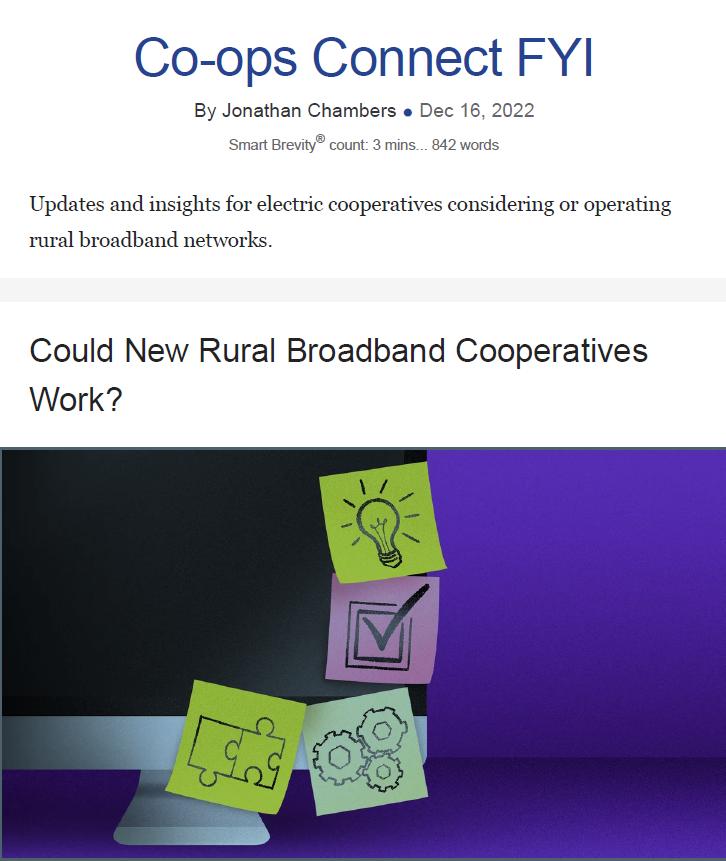Could New Rural Broadband Cooperatives Work?
December 16, 2022
The rural electric co-op broadband business:
- Most electric cooperatives involved in broadband operate their broadband business through a wholly owned separate subsidiary.
- In many cases, that arrangement is required by the state law governing electric cooperatives.
- In some cases, broadband is offered to non-electric members, who then become broadband members of the cooperative.
- There are also a small number of telephone or telecommunications cooperatives, founded in the 1940s, who provide broadband services to their members.
Is there another way?
Before the government spends another $40-60 billion of public funds, it is worth examining whether some parts of the country would benefit from the model used by the enormously successful rural electrification movement of the 1930s and 1940s.
The Role of Government Subsidies
As every electric cooperative understands (and seemingly no one else does):
Electric cooperatives did not get their start with government grants and subsidies.
- For 85 years, electric cooperatives have received loans from REA and then RUS, part of the US Department of Agriculture.
- Today, a significant number of electric co-ops have switched their borrowing in whole or in part to CFC or CoBank.
By contrast: Rural telephone companies received both low-interest loans and operating subsidies from federal and state government programs.
The big picture:
The dependency on government subsidies weakened the telephone industry over time.
- When the industry began to change, when competition started to eat into the monopoly rents, and when innovation and investment in fiber networks was necessary, the industry was hamstrung.
- To see how much the telephone industry had become dependent on monthly subsidies, just look up any recipient of FCC program subsidies.
One example:
Look up the subsidies received each month over the past 20 years by Public Service Telephone, a small Georgia incumbent telephone company. (Search for them by name in Georgia at the site above.)
The Universal Service Administrative Company (USAC) displays all monthly subsidies by program dating back to 2003 (the first year of this database).
For Public Service Telephone by the numbers:
- Has received over $150 million in subsidies from the FCC plus low interest loans from RUS.
- Continues to receive over $6 million annually in areas where other ISPs provide the majority of service.
- Was just awarded a ReConnect loan by RUS for areas where the state of Georgia awarded grants to other ISPs.
- All despite operating in a densely populated town in Georgia and facing competition from multiple internet service providers.
The bottom line:
Don’t think for a minute that the rules applied to the small telephone industry are the same as the rules applied to you and me.
A New Broadband Cooperative
I envision at least two types of rural broadband cooperatives:
1. Subsets of large electric co-ops where broadband is already available in most of the co-op territory.
2. Areas without an electric cooperative.
My thought bubble:
- I don’t propose ongoing reliance on subsidies for new broadband cooperatives.
- Nor do I think that a new cooperative can get up and running with loans only.
- Though the rural electrification movement is a uniquely American success story, it isn’t the 1930s anymore.
— RUS won’t loan to newly formed cooperatives.
— Neither will CoBank or CFC.
Yes, but: With $42.45 billion in rural broadband funding, a loan-only approach won’t be necessary.
- A grant from BEAD could well become sufficient for a new broadband cooperative to raise additional capital from members and loans from local banks or other financial institutions.
- States should contemplate, and NTIA should encourage, low-interest loans as part of their BEAD broadband plans.
The Final Word
Over the past 20 years, the FCC alone has distributed nearly $100 billion for rural, high-cost programs.
- In addition, the FCC has spent tens of billions on E-rate, Lifeline, and rural health programs that benefit rural America.
- RUS, NTIA, and other federal agencies have spent tens of billions on rural broadband.
- State governments have done the same.
The bottom line:
Money matters. But money alone won’t solve the digital divide.
Electric co-ops are the solution to closing the digital divide — but electric co-ops don’t cover the entire country and not every electric co-op will engage in broadband.
We need to try new things.
One more final thought:
Reform RUS.
- Many electric co-ops have shifted their borrowing to CoBank and/or CFC, even though RUS interest rates are lower.
- It would be well worth an examination by Congress and the leadership of USDA to understand what drives co-ops away from RUS.
- The quick answer? The bureaucratic thicket of RUS rules.
- It would be beneficial for USDA to justify the need for every existing rule and clear away some of that thicket.
- Such an approach would lower the cost of working with RUS in time and money.
